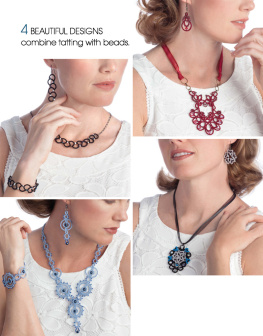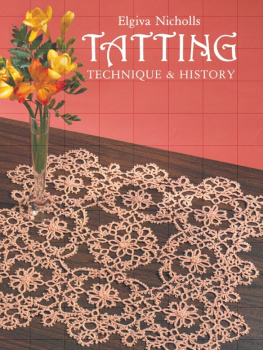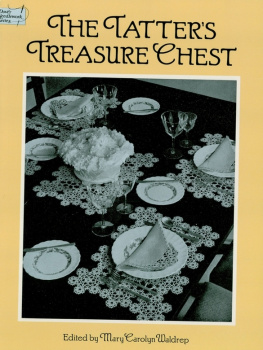Tatting
with
Anne Orr
Anne Orr
DOVER PUBLICATIONS, INC.
Mineola, New York
Copyright
Copyright 1989 by Dover Publications, Inc.
All rights reserved.
Bibliographical Note
This Dover edition, first published in 1989, and reissued in 2017, is an altered and abridged republication of Tatting, Book No. 13, published by Anne Orr, Nashville, Tennessee, n.d., and Star Book of Tatting Designs, Book No. 2, published by the American Thread Company, New York, in 1935. The patterns from the two books have been combined and rearranged. The photograph of and instructions for one item and the sections Abbreviations in Tatting, Note, How to Make Tatting, and List of Anne Orr Publications have been omitted from Tatting, Book No. 13, and several items have been renumbered. The photograph of and instructions for one item, and two additional photographs, have been omitted from the Star Book of Tatting Designs.
Library of Congress Cataloging-in-Publication Data
Orr, Anne Champe.
Tatting with Anne Orr / by Anne Orr.
p. cm.(Dover needlework series)
Altered and abridged republication of Tatting, book no. 13... n.d. and the Star book of tatting designs, book, no. 2, published... in 1935T.p. verso.
ISBN 978-0-486-25982-6
ISBN 0-486-25982-X
I. TattingPatterns. I. Title. II. Series.
TT840.T38077 1989
746.436041dcl9
88-34326
CIP
Manufactured in the United States by LSC Communications
25982X10 2017
www.doverpublications.com
Introduction
During her long career, Anne Orr became one of the most popular needlework designers of her time, and still remains one of the best-known names in the needlework field. During the years from 1914 to 1945, she prepared almost a hundred books of needlework designs, and, in addition, served as needlework editor of Good Housekeeping magazine for more than twenty years. She was proficient in all forms of needlework, creating designs for embroidery, quilting, knitting, crocheting, and, of course, tatting. In this, our ninth collection of Anne Orrs patterns and our second collection of her tatting designs, we offer instructions for doilies, luncheon sets, collars, yokes, baby bonnets, forty separate medallions, and over fifty edgings.
While the specific threads mentioned in the instructions may no longer be available, other threads can easily be substituted. Threads made specifically for tatting are available, and any smooth cotton thread used for fine crochet can also be used for tatting. The thread numbers used in the instructions to indicate the thread size are the same as those used today, so choosing a suitable thread should present no problem.
Instructions for Tatting

Tatting is a form of lace made with a tatting shuttle, and for some designs only one shuttle is needed, while for others two are required.
As will be judged, the simplest form of tatting is the ring which is made with one shuttle, and when a chain is introduced, the second shuttle is required. In learning to tat, the knot is made on the shuttle thread, and not with it though all the action is taken with the shuttle thread, shown in illustration No. 3. A second important fact to remember is that the shuttle thread is pulled taut before the knot is tightened.
First, wind the thread around the bobbin in the shuttle, layer over layer, but the thread should never extend over the edge.
To make a ring: Hold the shuttle between the thumb and forefinger of the right hand as shown. Hold the end of the thread between the thumb and forefinger of the left hand and pass it around the fingers of this hand, not too tightly, crossing it under the thumb. It is with this loop of thread that the ring is worked and this is called the ring thread. Throw the shuttle thread over the right hand as in illustration No. 1. Pass the shuttle between the first and second fingers of left hand under the shuttle and ring threads and back over ring thread, allowing the ring thread to fall slack by bringing the four fingers of the left hand together. Pull shuttle thread taut, then open the fingers of the left hand until the loop is caught with the thumb, as shown in No. 3.
For the second half, the thread is dropped instead of raised, shuttle is passed over the left-hand thread instead of under (as before), is brought through below between the two threads (as before) and drawn up in the same way. (Illustration No. 2.) Illustration No. 4 shows the second half of stitch slipping into place beside the first half.
This group is called a double stitch and is the main stitch used in tatting. In making this, it will be found that by pulling the shuttle thread and then the ring thread, the stitch slips back and forth on the shuttle thread. If it does not, the stitch has been locked and must be made over again.
Illustration No. 5 shows a picot which is made by leaving a space of thread between the stitches, and to join two picots, draw the working thread through the picot and pass shuttle through loop. Then draw up close to resemble a half stitch, but not to be counted as one.
Two shuttles are required to make a design having a chain. Tie the threads together and hold between the thumb and second finger of the left hand and with the first finger outstretched, wind the thread around it two or three times, allowing the second shuttle to drop as on No. 6. The stitches for the chain are made with the thread between the first and second fingers in the same way as those for the rings.

DIRECTIONS FOR THE REVERSE STITCH
Begin ring, making three double stitches, picot, two double stitches, picot, three double stitches (figure one) (this is one-half of ring), take work off from hand* (reverse), turn over (figure two), put work on hand so that the thread which was under is now over the hand. Take shuttle No. 2 and make the other half of the ring, with the reverse stitch, which is done by holding the thread on the hand taut, and making the stitch with the thread from the shuttle, making three double stitches, picot, two double stitches, picot, three double stitches (figure three), take work from hand, turn over*, take shuttle No. 1 and close ring (figure four).
In joining while doing reverse work, do not draw shuttle very taut after passing through joining loop, but draw the loop back again so that the joining stitch is made with the thread from shuttle and the thread on the hand may be drawn back and forth.
ABBREVIATIONS IN TATTING
r st | Stands for reverse stitch. |
sl st | Stands for slip stitch. |
ds | Stands for double stitch. |
r | Stands for ring. |
p | Stands for picot. |
ch | Stands for chain. |
s ch | Stands for short chain. |
1 ch | Stands for long chain. |
lp | Stands for long picot. |
j | Stands for join, joined, joining. |
sp | Stands for space. |
cl | |















